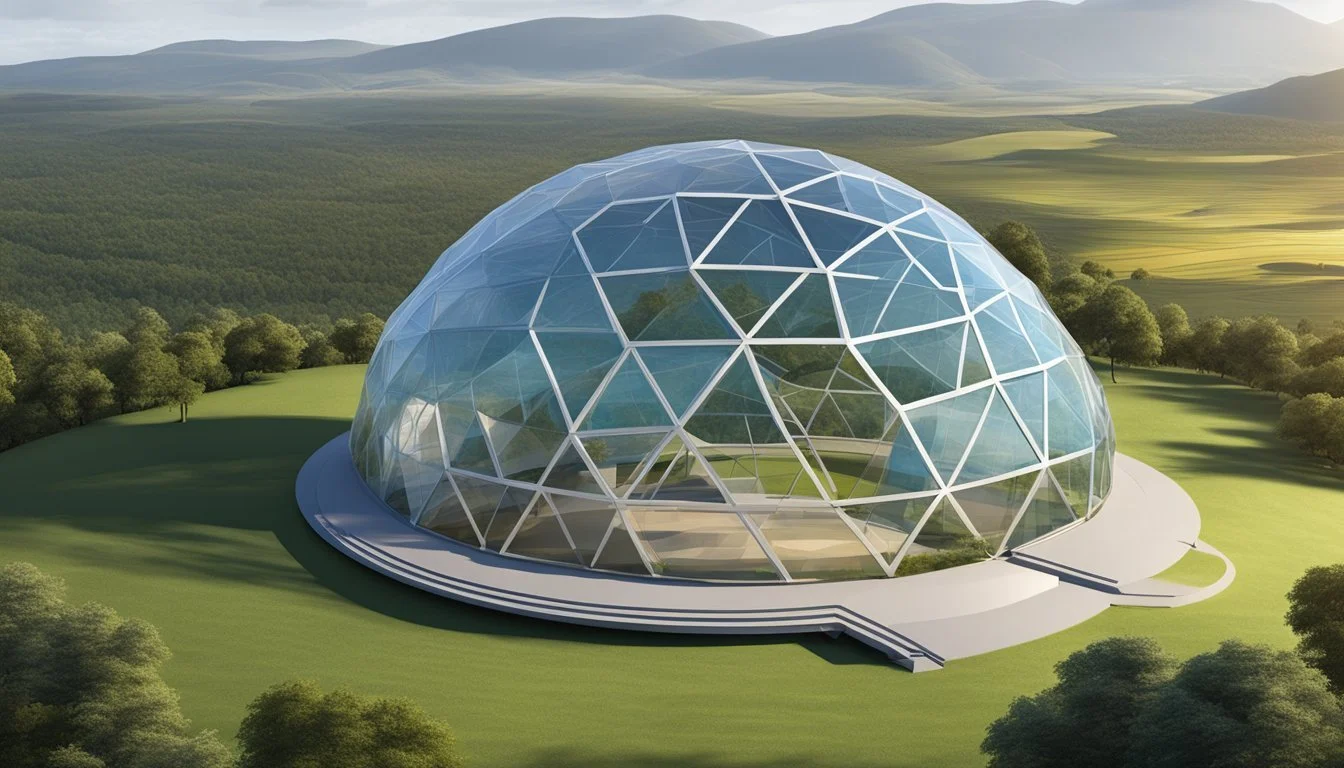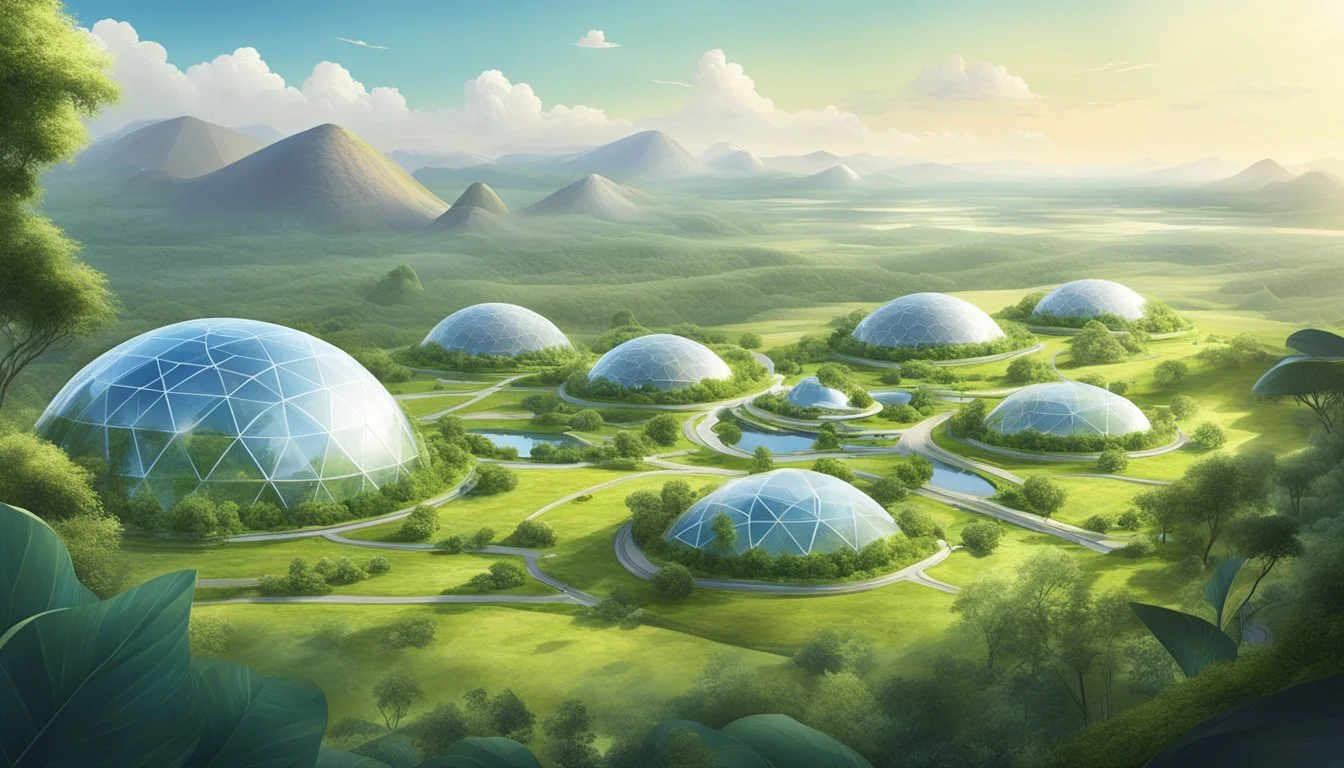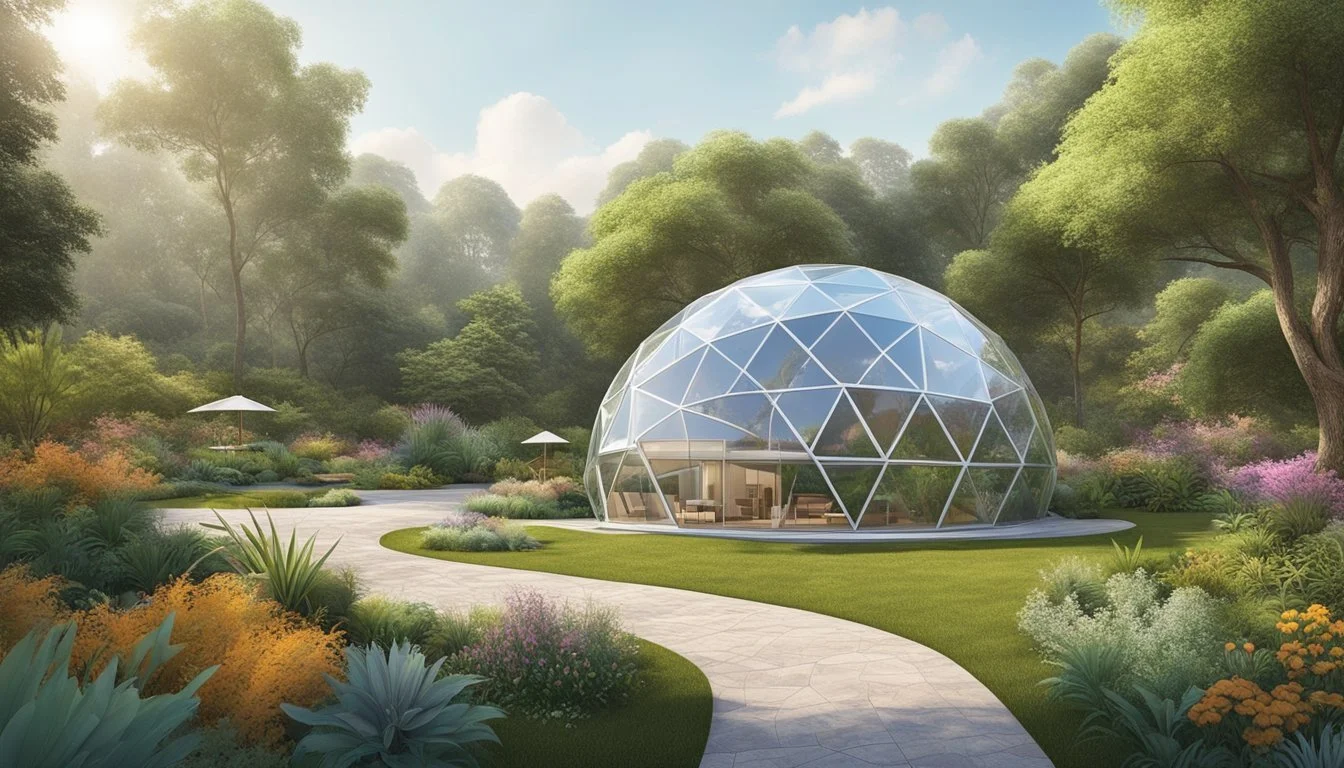Free Land for Geodesic Domes
Futuristic Housing Solutions
Imagine owning a home that is not only uniquely captivating but also significantly eco-friendly. Geodesic domes offer precisely this, combining the visionary designs of architect Buckminster Fuller with advanced sustainable living. These dome-shaped structures, composed of interconnected triangles, maximize strength and efficiency, making them an ideal choice for those seeking to minimize their environmental impact.
Many areas are now offering free land for the construction of these futuristic homes. Obtaining free land for geodesic domes presents a groundbreaking opportunity for reducing housing costs while promoting sustainable living. Geodesic domes are highly energy-efficient, reducing heating and cooling expenses due to their aerodynamic shape and efficient use of materials.
Communities willing to invest in sustainable housing are increasingly providing incentives like free land to attract builders of geodesic domes. This initiative not only benefits the environment but also fosters a unique and progressive living experience. Whether you are drawn to their durability, aesthetic appeal, or the promise of a greener lifestyle, geodesic domes represent the future of eco-conscious architecture.
Historical Overview of Geodesic Domes
Geodesic domes have a rich history rooted in innovation and sustainability. They have evolved over the years from experimental structures to widely-adopted architectural solutions.
Invention and Evolution
The concept of the geodesic dome began in the early 20th century, primarily as an exploration of geometric efficiency. The structured framework, typically composed of interconnected triangles, distributes structural stress evenly, allowing for large, stable constructions using minimal materials.
The first patents for geodesic domes appeared in the 1920s. Over the decades, developments in materials such as lightweight metals and durable plastics facilitated the construction of more versatile and longer-lasting domes. By the mid-20th century, geodesic domes had been embraced for various applications including military, recreational, and residential purposes due to their resilience and cost-effectiveness.
Buckminster Fuller and His Legacy
R. Buckminster Fuller played a pivotal role in popularizing the geodesic dome. Born in 1895, Fuller was an innovative American architect known for his forward-thinking designs and sustainability focus. He saw the potential of geodesic domes to provide affordable, efficient housing solutions.
Fuller's own home in Carbondale, Illinois, was a geodesic dome, showcasing his commitment to the structure. His work led to the widespread acceptance of geodesic domes in both academic and practical realms. Fuller's influence remains evident today, as geodesic domes are used in diverse fields such as eco-friendly living, disaster relief, and more, highlighting his vision of using design to address global challenges.
Design Principles of Geodesic Domes
Geodesic domes are celebrated for their unique geometric design, exceptional strength, and energy efficiency. Their innovative structure leverages geometric principles to optimize stability and insulation.
Geometric Fundamentals
The defining feature of a geodesic dome is its reliance on triangles. These polygons provide a rigid framework, ensuring structural integrity. The framework consists of numerous interconnected struts that form triangular components, which distribute stress uniformly across the structure.
This spherical shape allows for the even distribution of forces, making it capable of withstanding heavy loads and adverse weather conditions. The geometry also minimizes material usage while maximizing enclosed space, achieving high efficiency.
Strength and Stability Factors
The strength of geodesic domes lies in their structure. Each strut in the triangular network shares the load, making the entire framework remarkably robust. This design makes geodesic domes more resilient to natural disasters such as earthquakes and hurricanes compared to conventional buildings.
Furthermore, the interconnected triangles spread any external stress across the dome, enhancing its stability. The dome's geometry ensures that each element supports its neighbors, resulting in a balanced and resilient structure.
Energy Efficiency Considerations
Geodesic domes excel in energy efficiency due to their spherical shape and minimal surface area relative to volume. This shape reduces heat loss and improves insulating properties, which is crucial for maintaining a consistent internal temperature.
The efficient design of geodesic domes also offers advantages in ventilation and air circulation, reducing the need for mechanical heating and cooling. This natural efficiency, alongside the potential for incorporating sustainable materials, makes geodesic domes an environmentally friendly housing option.
Materials and Construction
Geodesic domes are celebrated for both their structural integrity and efficient use of materials. The following subtopics will discuss the specific techniques and materials involved in their construction as well as methods for insulation and environmental control.
Construction Techniques
Geodesic domes utilize a unique, spherical design comprised of interconnected triangles, which provides remarkable strength. Steel and wood are common framing materials, offering both durability and flexibility. Metal joints are often used to connect the struts, ensuring stability and ease of assembly.
Bioceramic materials are emerging as a popular option due to their long lifespan and resistance to rot, burn, and rust. Panels made from glass or polycarbonate are frequently used for windows, allowing natural light to flood the interior.
For the foundation, concrete is typically used, providing a solid base that can withstand various environmental conditions. The construction process is relatively quick, thanks to the modular nature of the components.
Insulation and Environmental Control
Proper insulation is crucial for maintaining energy efficiency in geodesic domes. Materials such as spray foam insulation or bioceramic insulation are popular choices because they provide excellent thermal resistance and are easy to apply. These materials reduce heating and cooling costs significantly.
Environmental control is another strength of geodesic domes. The spherical shape allows for even distribution of air and heat, minimizing energy consumption. Ventilation systems can be integrated to regulate airflow, while thermal mass materials like concrete can store and release heat as needed.
Reflective coatings on glass panels can further control temperature by reducing solar gain. Additionally, many geodesic domes incorporate green roofs or solar panels to enhance sustainability.
Environmental Impact and Sustainability
Geodesic domes offer significant benefits in terms of environmental impact and sustainability. These benefits primarily include a reduced carbon footprint and the use of eco-friendly materials in construction and maintenance practices.
Reducing Carbon Footprint
Geodesic domes are designed to be energy-efficient. Their spherical shape reduces the surface area that is exposed to external elements, minimizing heat loss in winter and cooling loss in summer. This efficiency leads to lower energy consumption for heating and cooling.
Additionally, the structural strength of geodesic domes allows for the use of lighter materials, reducing the energy required during construction. This architectural design also supports the integration of renewable energy sources such as solar panels and wind turbines, further reducing the reliance on fossil fuels.
By lowering energy needs and enabling the use of renewable energy, geodesic domes significantly contribute to reducing the carbon footprint of a household. This makes them an excellent choice for eco-conscious individuals looking to make sustainable living a reality.
Eco-friendly Materials and Practices
The construction of geodesic domes frequently involves sustainable and recycled materials. Builders often use FSC-certified wood, bamboo, and recycled steel. These materials are not only durable but also have a lower environmental impact compared to traditional construction materials.
Furthermore, geodesic domes can incorporate green building practices. This includes using non-toxic finishes, natural insulation materials, and rainwater harvesting systems. The efficient design reduces the amount of construction material needed, cutting down waste and promoting sustainability.
Landscaping around geodesic domes often includes native plants that require minimal water and maintenance. This practice supports local ecosystems and reduces the need for chemical fertilizers and pesticides, enhancing the overall environmental sustainability.
Architectural Benefits and Challenges
Geodesic domes offer a range of architectural benefits such as energy efficiency and resilience, but they also present certain technical and structural challenges that must be addressed.
Aesthetic and Functional Advantages
Geodesic domes boast a unique shape formed by interlocking triangles, which provides both visual appeal and functionality.
The design maximizes the use of space, resulting in a structurally sound and efficient dwelling. This shape allows for even distribution of stress, making the structures resilient to natural disasters like earthquakes and floods.
Additionally, the curved surface ensures better air circulation and heating efficiency. The use of sustainable materials further enhances their appeal among eco-conscious individuals.
Their unconventional appearance has the potential to redefine the future of architecture, combining aesthetics with practical eco-friendly solutions.
Technical and Structural Challenges
Building a geodesic dome involves significant technical hurdles, particularly in ensuring structural integrity.
The complexity of the design requires precise calculations to properly assemble the interlocking triangles.
Moreover, the curved geometry can complicate the installation of conventional building systems such as plumbing and wiring.
Material selection and construction methods need to be carefully managed to avoid compromising resilience.
Additionally, despite potential cost savings, initial construction can be labor-intensive and may require specialized skills.
Architects and builders must also account for climatic conditions and location-specific factors to optimize longevity and performance.
Applications of Geodesic Structures
Geodesic structures demonstrate versatility across various applications, including residential homes, commercial buildings, and specialized purposes such as greenhouses and habitats.
Residential Homes and Affordable Housing
Geodesic dome homes offer significant benefits for those seeking energy-efficient and sustainable living. The inherent design of geodesic domes reduces heating and cooling costs due to excellent air circulation and reduced surface area.
These structures often use natural, sustainable materials, appealing to eco-conscious individuals. Affordable housing initiatives also recognize the cost-effectiveness of geodesic domes, making them an innovative solution for budget-friendly accommodations. Their construction typically requires fewer materials and less labor, translating to lower cost per unit.
Commercial and Public Structures
Many commercial and public buildings benefit from the structural integrity and aesthetic appeal of geodesic domes. Exhibition spaces, event halls, and entertainment venues frequently employ these domes for their unique look and expansive interiors.
Domes provide a large, column-free space, making them ideal for hosting large gatherings. Retail spaces and educational institutions are also exploring geodesic designs for their energy efficiency and modern feel.
Additionally, these structures can withstand extreme weather conditions, making them suitable for various geographic locations.
Specialized Applications
Geodesic domes see diverse specialized uses, such as greenhouses, research facilities, and biomes. Their shape promotes consistent sunlight distribution and optimal growing conditions, making them perfect for greenhouses.
Research organizations use geodesic domes to create controlled environments, such as biospheres, for studying ecological systems. Habitat construction for extreme environments, ranging from Arctic outposts to space habitats, also benefits from the durability and efficiency of geodesic domes.
These specialized applications highlight the structure's adaptability and strength, providing safe and functional solutions in challenging conditions.
Future Outlook
Geodesic domes represent more than just a housing trend; they symbolize a forward-thinking approach to sustainable and innovative living. As new advancements unfold, these structures could redefine where and how humans live, both on Earth and beyond.
Innovative Projects and Visionaries
Several pioneers and organizations are spearheading the development of geodesic domes. Geoship, for instance, is creating bioceramic domes capable of withstanding extreme conditions. These efforts include collaboration with companies like Zappos to provide homes for the homeless.
Artists and scientists alike are contributing to this vision. The integration of art within these domes fosters a sense of community, while scientific innovations ensure they are energy-efficient and sustainable. Together, these elements are pushing the boundaries of architectural norms and eco-friendly living.
Extraterrestrial Habitats: Beyond Earth
Geodesic domes hold potential not only for Earth but also for extraterrestrial habitats. NASA and other space agencies are exploring their use for Mars colonization. Their robust and efficient design makes them suitable for protecting inhabitants from harsh planetary conditions.
Within planetariums and research institutions, scientists are studying geodesic domes as viable options for space settlements. These structures could enable sustainable living on other planets, marking a significant step forward in human extraterrestrial exploration.
Societal Implications
The introduction of geodesic domes as housing options holds the potential to address significant societal challenges, including the global housing crisis and the promotion of sustainability. This section delves into these critical implications.
Addressing the Global Housing Crisis
Geodesic domes offer a promising solution to the global housing crisis. The construction costs for these structures are relatively low compared to traditional housing, with prices ranging from $50,000 to $500,000 in the United States. This affordability can enable widespread access to durable, long-lasting homes for underserved populations.
Additionally, many organizations and companies, such as Zappos, are exploring innovative housing projects that utilize geodesic domes. These domes can be rapidly assembled, which is crucial for disaster relief and emergency housing needs. Their energy-efficient design further reduces utility costs, making them economically viable for low-income families.
Educational and Cultural Influence
Geodesic domes also have the potential to impact education and culture significantly. They can serve as eco-friendly educational centers where students learn about sustainability and innovative architecture. Schools and universities might incorporate these structures into their campuses to promote environmental consciousness.
Culturally, these domes can become community hubs, fostering a sense of unity and cooperation. Their unique design and aesthetic appeal can inspire creativity and innovation, encouraging the community to adopt more sustainable living practices. Public awareness about environmental issues can be heightened through the daily interaction with these eco-conscious dwellings.
Maintenance and Longevity
Geodesic domes, known for their unique structure and strength, require specific maintenance techniques to ensure long-term durability and functionality. These homes demand attention to both general upkeep and potential repurposing opportunities.
Upkeep and Durability
Regular maintenance is essential to preserve the structural integrity and longevity of geodesic domes.
Insulation: The foam insulation used in many domes should be protected either through painting or covering with a UV-resistant layer to prevent degradation.
Moisture Control: Vigilant monitoring for mold and moisture infiltration can prevent long-term damage. Sealing any leaks promptly and employing dehumidifiers can keep the internal environment healthy.
Foundation: Whether constructed on a concrete slab or alternative foundation, periodic inspections for cracks or shifts can prevent larger issues.
Exterior Maintenance: The unique shape of geodesic domes often requires specific roofing materials that need careful inspection and replacement over time to avoid water damage.
Adaptation and Repurposing
Geodesic domes can easily adapt to evolving needs, offering versatile opportunities for repurposing.
Customizable Floor Plans: The absence of load-bearing walls allows homeowners to modify internal spaces with ease, accommodating new designs and functionalities based on changing requirements.
Material Reuse: Sustainable materials used in initial construction, such as reclaimed wood or metal, can be repurposed during renovations, maintaining eco-friendly standards.
Energy Efficiency Upgrades: Homeowners can integrate modern, energy-efficient technologies like solar panels, ensuring the dome remains functional and cost-effective.
Expansion Options: Existing domes can be expanded by adding new modules or structural elements, allowing for growth without compromising the original design and durability.
By focusing on maintenance and the potential for adaptation, geodesic domes provide long-term, versatile living solutions that align with modern, sustainable living goals.










